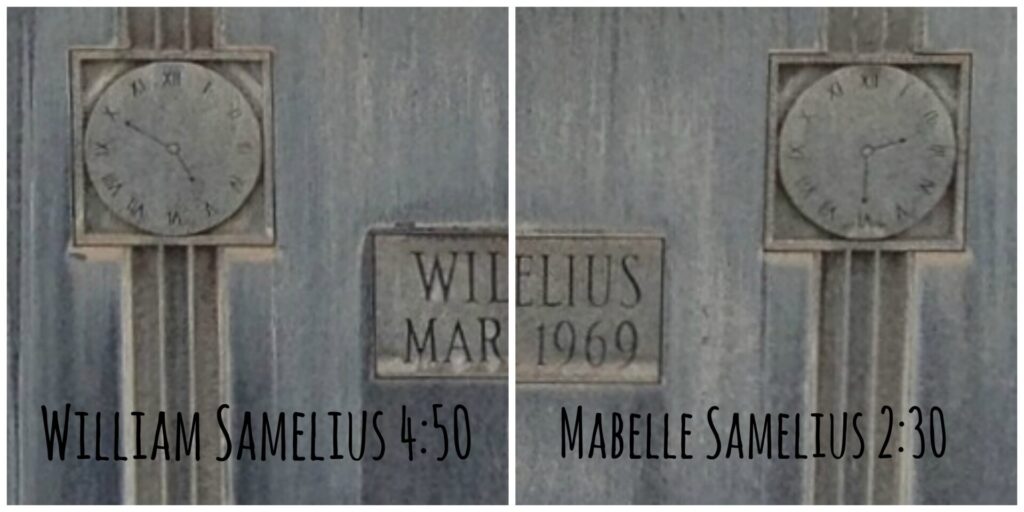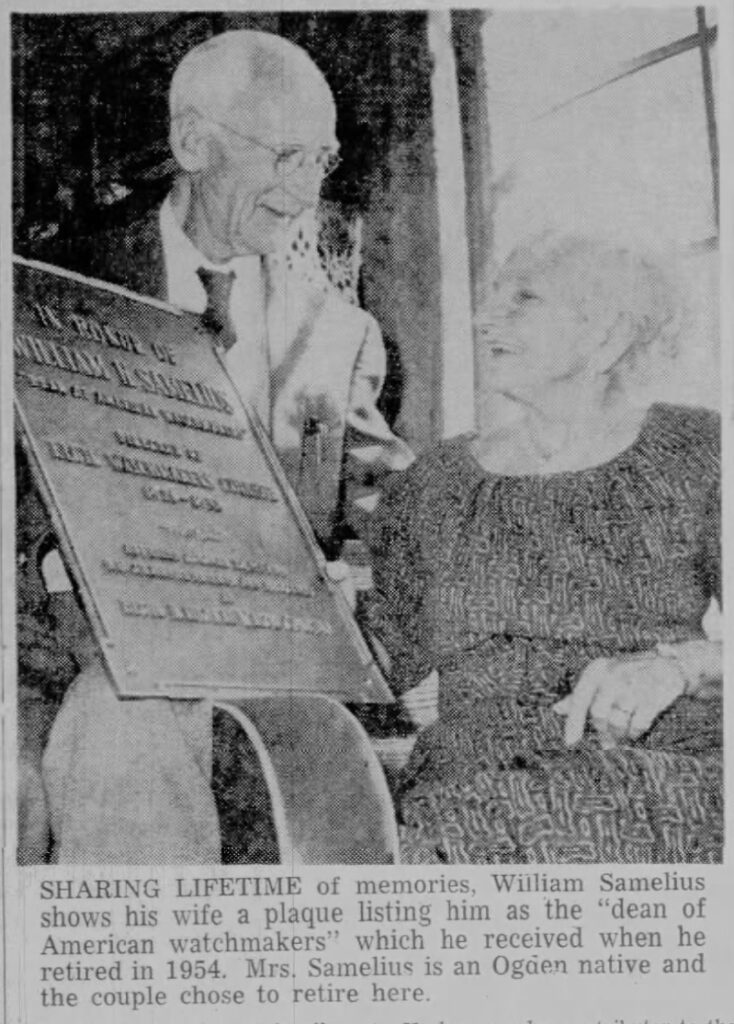Discovering a Unique Monument
Much to my children’s disappointment, I love wandering through cemeteries, camera in hand. They usually get dragged along — it builds character, right? We often visit the Ogden City Cemetery since it’s close, old, and filled with unusual headstones. No matter how many times I go, I always find something new, like the William Samelius grave.
One day, a large monument caught my eye. Something about it felt different, so I stopped for a closer look.
William H Samelius – Dean of American Watchmakers. His contributions to horology during a long and vigorous life are immortal. He had the joy of working with the finest fabric of God’s universe. The measurement of the passing of time.
Pretty great epitaph, right? His epitaph was unlike any I’d seen before. The words on the William Samelius grave weren’t just a tribute — they captured a lifetime of dedication to time itself.
The Mystery of the Clocks
I then noticed that a couple were buried there, and the small clocks with specific times next to their names caught my attention. Since each clock displayed a different time, I suspected they marked their times of death. Curious about William Samelius, I set out to uncover his story and determine if my theory about the clocks was correct.

A Lifetime Devoted to Time
I discovered that people widely knew and respected William Samelius as a master watchmaker. Samelius didn’t just become a master watchmaker, he was born into the craft. His father was the royal watchmaker of Sweden, a skill that Samelius would later refine and expand upon in the United States. As a young watchmaker, Samelius designed a complex, gearless watch that even master craftsmen struggled to understand. The King of Sweden saw his invention, grew so impressed, and granted Samelius a five-year sabbatical to travel the world and study horology.







During World War I, Samelius served as an Army inspector, ensuring the precision of firing and timing mechanisms for 77m guns. His knowledge of watchmaking translated into wartime innovation. This proved that mastering timekeeping had life-or-death consequences.
His experience in military precision only deepened his passion for watchmaking. To Samelius, it was an art of extreme precision. His students learned to measure tolerances as small as 0.0001 inches. This is equivalent to splitting a human hair lengthwise 30 times. Watchmakers had to ensure that even the tiniest screws, small enough for 20,000 to fit inside a sewing thimble, had perfect threading.
Over his career, Samelius trained more than 4,500 watchmakers, ensuring the craft continued for generations. Elgin Watchmakers College valued his expertise so highly that, even after he retired in 1954, they named him honorary director for life. He came from a long line of expert watchmakers. His family once made watches for Swedish royalty, a fitting legacy for a man known as the Dean of American Watchmakers.
A Visionary Ahead of His Time
William Samelius wasn’t just a master watchmaker, he was also a forward thinker. In the 1940s, he predicted that radio-controlled watches would emerge, synchronizing with a central broadcasting station.
At a horology convention, Samelius noted that the U.S. Bureau of Standards had already tested radio-controlled clocks that could receive signals up to 100 miles away. He believed it was only a matter of time before private companies brought this technology to consumers.
The Future He Predicted
- 1970s-1980s: Commercial radio-controlled clocks became widely available.
- 1990s: The first radio-controlled wristwatches launched in Germany and Japan.
- 2000s-Present: Radio-controlled and atomic watches sync to government time stations worldwide, including WWVB in the U.S.
- Today: His idea extends even further. Smartwatches now sync to global time servers via the Internet and satellites, keeping time more accurately than ever.
Ahead of His Time
Samelius’ passion for precision wasn’t just about watchmaking. It was about pushing the boundaries of how we measure and experience time. His prediction highlights just how forward-thinking he was. This proves that even in the 1940s, he was already envisioning the future of timekeeping.
He was the director of the Elgin Watch College in Elgin, Illinois for many years. William also published numerous books on the subject of horology and watchmaking. He moved to Ogden from Long Beach, California in 1960 after marrying Mabelle Greenwood at the age of 87. Despite retiring, Samelius never slowed down. Even in his late 80s, Samelius danced with Mabelle multiple times a week, embracing very moment and proving his belief that time was meant to be lived fully.

Unfortunately for Mr. and Mrs. Samelius, his life in Ogden was short lived. William Samelius died on November 5, 1961, at the age of 88. His death certificate states the time of death was 2:30 pm.
Final Resting Place – and a Possible Mistake
Since William’s death certificate confirms 2:30 PM as his time of death, but his clock shows 4:50, it seems likely that the engraver accidentally swapped their times.
So the next time you find yourself in a cemetery, look for a headstone that catches your eye. Do a bit of research to learn more about the person. You never know who you might find buried in your local cemetery. Maybe you too will discover a story as fascinating as the tale behind the William Samelius grave.


0 comments
Certainly not forgotten to the watchmaking community. William Samelius’ name is one that is honored and revered for his contributions to American Watchmaking.
Sounds like he was a very interesting character!